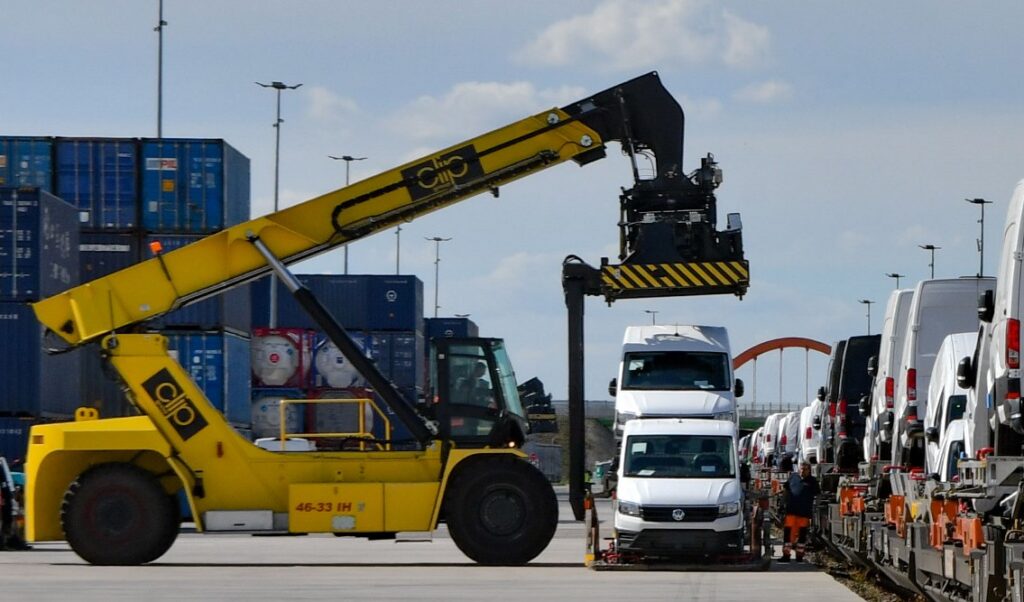
Most semi trailers can now be lifted by crane onto rail wagons using a system developed by logistics major VEGA.

The logistics service provider for truck and trailer manufacturers around the globe has introduced the r2L 2.1 Trailer Use system, which can load any rubber wheeled vehicle on to standard pocket rail wagons using existing cranes. Truck tractors can also be handled by the system.
Initially developed for the intermodal transport of commercial vehicles in Europe the roadrailLink, a lightweight version of the adapter can be fitted on to road trailers, which can be driven between the rail head and the factory for loading and unloading.
Thanks to the universal applicability of the system, inbound and outbound traffic can for the first time be combined and thus made more efficient in automotive logistics on rail, according to VEGA. Three block trains are currently in use on the routes between Trieste – Karlsruhe; Verona – Rheine; and Verona – Poznan, according to the company.
The r2L system handles non-craneable semitrailers in the same way as craneable ones. Specifically, the concept uses a galvanized metal plate. Trailers are driven onto the metal plate, which then can be lifted by either a reach stacker or terminal gantry crane. A train with 16 double pocket wagons can accommodate 32 semi-trailers, or 64 truck tractors, or 96 vans – or a combination of the three.
It differs from similar systems in the market in that it does not require a loading ramp. The cargo handling can take place right in front of the rail wagon. According to Vega, the technology is suitable for use in more than 90% of European terminals.
Automotive Industries (AI) asked Franz Blum, CEO/Director of VEGA International Car Transport & Logistic Trading, what the motivation was behind the development of the system.
Franz Blum: The climate target of the European Commission demands urgent action be taken by manufacturers to shift more cargo from road to rail in order to achieve CO2 savings. VEGA Logistics has always been aware of the challenges of combining reliable logistic chains for the commercial vehicle industry with the sustainable utilization of natural resources.
As a partner of all European truck and trailer manufacturers VEGA had years of practical experience in the market-place to draw on when we started developing a system which would enable us to move any kind of trailer easily and quickly from road to rail and back.
The roadrailLink Trailer Use adapters will fit into most of the multimodal bag waggons currently in use. They can be seen as the missing link between the two modes of transport.
AI asked Peter Blum, Chief Operational Management, Vega International Car Transport & Logistic Trading, to quantify the impact of the new system.
Peter Blum: The potential of CO2 saving is huge. Each adapter can reduce the CO2 footprint of land logistics by 200 tons a year – which means that manufacturers can make significant reductions in their overall carbon footprint right now. The first logistics operator to understood this potential was the Danish Company DFDS, which has rented 55 adapters for its rail lanes from Trieste to Bettembourg and for further on to Lyon and Rostock. New lanes like Cologne or Zeebrugge are expecte

d to be added soon.
Bettembourg in Luxembourg is the DFDS continental hub for intermodal connections. According to DFDS, the acquisition of Turkish company UN Ro-Ro means that DFDS is now in a position to offer a fast intermodal connection from Gothenburg in Sweden to Trieste in Italy, Patras in Greece and Pendik, Ambarli and Mersin in Turkey.
AI: How long does it take to move a trailer between road and rail?
Peter Blum: Laser distance measuring technology minimizes human error and speeds up the loading process. A non-craneable trailer can be loaded from directly in front of the rail wagon in less than two minutes. This addresses the two shortages all terminals face – time and space.
AI: How has the industry responded?
Franz Blum: VTG, a leading international wagon hire and rail logistics company, has signed a frame agreement with VEGA to equip their pocket wagon fleet with the adapters. The first units have already been delivered to them and are running on different lanes between the Netherlands and Poland, as well as between Lithuania and Germany.
This brings the total to more than 300 adapters already in the European rail network, with a potential CO2 saving of 60,000 tons of carbon a year. The number of adapters will grow significantly in 2021/2022 as the climate targets are getting more and more challenging.
AI: How big is the potential market?
Peter Blum: There are an estimated 1.5 million trailers in the European transport market, of which only around five to six per cent are craneable, so the market is huge, and we expect to see a rapid growth in the demand for roadrailLink adapters throughout the continent.
Just recently VEGA was invited to a wagon manufacturer in Spain, which is working on the development of a pocket wagon designed for the Spanish rail system. What they were looking for was the specifications of the adapter in order to be able to use it on Moroccan trailers coming via Algeciras to Europe.
AI: Will we see more freight moving onto rail?
Franz Blum: Intermodality will be the name of the game for the next few decades to enable manufacturers of commercial vehicles and trailers to meet the climate goals set by the European authorities. VEGA has developed the right tool to facilitate the movement of trailers between road and rail – and to get the green deal on track!











More Stories
8 Best Plastic Welding Techniques for Automotive Manufacturing
5 Big Reasons to Choose LED Bulbs for Your Car Headlights
How much does it cost to ship a car on Amtrak Auto Train?